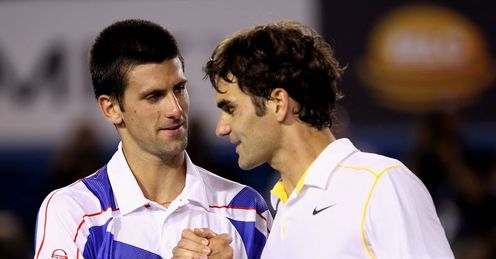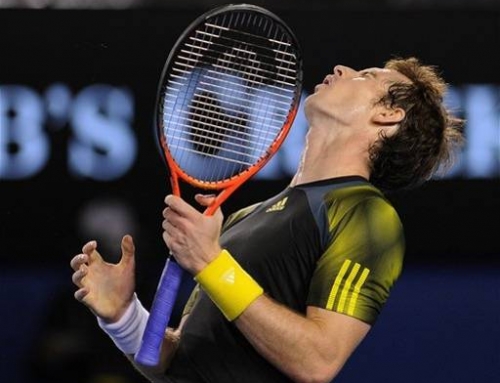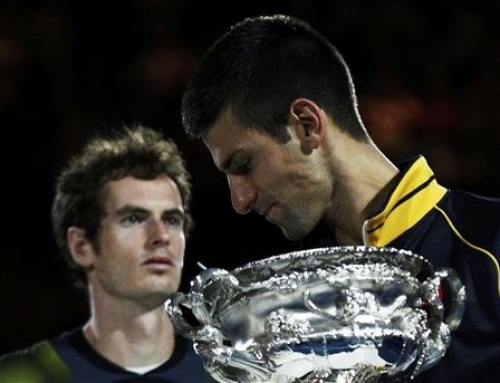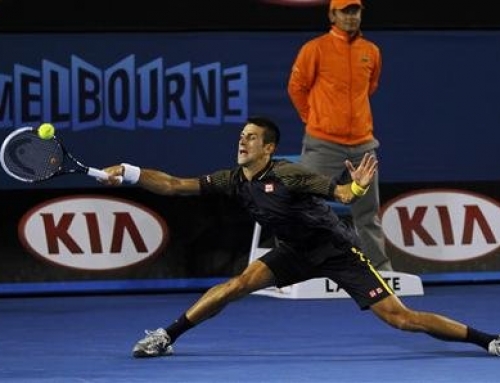 If you looked at the form of the players the last 2-3 months, Federer was the man. He won Stockholm. He won Basel. He won the year-end championship without dropping a match. This included a defeat of his main rival, Rafael Nadal. He started the year playing well, winning Doha over Davydenko.
If you looked at the form of the players the last 2-3 months, Federer was the man. He won Stockholm. He won Basel. He won the year-end championship without dropping a match. This included a defeat of his main rival, Rafael Nadal. He started the year playing well, winning Doha over Davydenko.
Nadal ended last year somewhat decently. As usual, he struggled some after the US Open. He lost to Guillermo Garcia-Lopez at Bangkok. He won Tokyo over Monfils, but had to save match points and break to beat a game Viktor Troicki. He lost to Jurgen Melzer at Shanghai. He then took a break, skipping Paris, hoping the rest and training would allow him to capture the one title that has eluded him: the year-end championship.
Nadal swept his round-robin, which lead him to a semifinal encounter with Andy Murray. That was the best match of the tournament and one of the best of the year, with Nadal hitting the biggest shots at the biggest moments, and beating the tenacious Scot.
When Nadal returned back to action, he won a 6-man exhibition in Abu Dhabi beating Roger Federer in two tiebreaks. But, at Doha, a real tour event, Nadal fell ill, and struggled to win his matches. Although Davydenko was not himself in full-form, it was good enough to beat Nadal.
Still, despite everything, everyone assumed Nadal was Nadal. He might play poorly heading into a Slam (like he did at the US Open), but he peaks better than most playing at Slams. In any case, because of the seeding, you can usually work your way into a Slam. Nadal was proving this by working his way through the draw and then met his greatest enemy. His own body. And a hot-hitting David Ferrer who was more than capable of handling a hobbled opponent.
And where was Djokovic? He had a very solid post US Open, as he normally does. He won Beijing over David Ferrer, a sign that Ferrer was having a great year (on clay and on hard courts). The rest of the year was mostly playing second fiddle to Roger Federer. He lost to Federer in the semis of Shanghai. He lost to Federer in the finals of Basel. He lost to Federer in the semis at the year-end championship at London. Three losses in the space of about two months.
It was looking like Federer’s loss to Djokovic was a bit of a fluke. Even Federer, who will make subtle excuses, thought so too. Concerned that he would have to play Nadal after a long match with Djokovic, Federer said he essentially gave up on two sets and put all his eggs in one basket, hoping to win in a fifth set. With match points in hand, he didn’t expect Djokovic to go for his shots and eventually win.
Much like Murray, Djokovic decided to open his year playing the mini-Davis Cup exhibition, the Hopman Cup. Eight teams consisting of one male, one female, playing singles and mixed doubles are split into two groups of 4 with one team emerging out of each group. Clearly, Djokovic and Murray was the class of the field, but they were in separate groups, and never played each other.
There are several benefits of Hopman Cup. First, you’re guaranteed three singles matches in the round-robin. Second, you can work on your net skills some in the mixed doubles. Third, the opponent quality is good, but not great. You won’t see Berdych or Federer or Nadal playing Hopman Cup. Fourth, it’s being played in Australia, so you can adjust to the heat (Doha is hot, but all matches are played at night where it’s decidedly hot). Finally, it’s fun. There’s no huge pressure since it’s an exhibition. Players play for real since it’s good training, but losing isn’t the worst thing. Last year, UK met Spain in the final and Murray lost to Tommy Robredo. He still made the Aussie Open finals.
Heading into the Australian Open, everyone felt that Federer and Nadal were the class of the field. This is generally the case for every Slam, but Federer had been playing pretty hot since the US Open. Nadal hadn’t played nearly as well but he usually peaks at Slams, so no one was about to deny the holder of 3 of 4 Slams the unofficial title as co-favorite.
This isn’t to say Murray and Djokovic weren’t also considered strong contenders. Both had played solidly last year, and reached the semis at London. Djokovic was feeling particularly good, helping his team win the Davis Cup for the first time ever. Murray won in Shanghai and had a pretty solid fall.
But when it came to form, Djokovic was perhaps the class of the field. Federer looked dominating out of the gate against a lesser opponent, but was pushed to five sets against Gilles Simon. He lost a set to Tommy Robredo. He beat Malisse and Wawrinka in straight sets, but there were chinks in the armor. Mishits were creeping back into his game. Federer was starting to slice his returns more after taking a more aggressive posture to win London. Federer just looked better at London then he did in Melbourne.
Meanwhile, except for a one set hiccup against Ivan Dodig, Djokovic was simply rolling. Even his tiebreak loss to Dodig was followed by two lopsided sets. For once, the weather at Melbourne wasn’t so oppressively hot, at least, not every day, and Djokovic was not suffering like he normally does. But the big win for Djokovic was his quarterfinal win over Berdych. The two played a close second set, but Djokovic won that, and then won that match going away.
It wasn’t just that he won, but the way he won. He was able to keep Berdych from using his power, something he did very well against Verdasco, by consistently hitting behind him.
Djokovic was helped by a serve that was finally getting back to the form he once had. Djokovic had one of those unenviable stats for a top pro. He had been averaging more double-faults than aces. However, Djokovic’s serve was starting to come back and he was starting to get a few free points once again. Although he doesn’t get enough credit for it, Djokovic is also one of the game’s better returners. He may not hit winners on returns, but he gets enough pace and enough balls back to trouble nearly everyone.
So when Djokovic and Federer met for the semis, the thinking about how this match would turn out had changed. Federer, who had been, by form, the favorite heading into the Australian Open, had been playing patchy tennis. Meanwhile, Djokovic had been looking very good in all his matches, minus that tiebreak. If you asked a serious observer who was in better form, the answer was Djokovic.
The first set was a battle with both players striking the ball well. The one disturbing note, from Fed’s perspective, was the very long rallies. Federer normally gets to a point where Djokovic is off-balance, and then plays aggressively with winners to either side. Djokovic was weathering this storm quite well. Djokovic’s brand of defense is quite different from Murray. Murray is often scrambling, as he did with Dolgopolov, and barely getting his racquet on, sometimes offering only slice forehands or backhands.
Djokovic, on the other hand, seems like a wall. He not only gets to balls, he hits solid shots off every one. With Federer needing ten shots to win or lose a point, he was playing to Djokovic’s hands.
Neither player lost serve in the first set, so they went to tiebreak, where those Federer errors and Djokovic’s tough play meant a quick Djokovic lead and then the set.
In the second set, Djokovic took the early break, but suddenly Federer lifted his game while Djokovic’s dropped some. Federer broke back then broke a second time. Djokovic was able to hold, but then with Federer serving for the second set, Djokovic broke, and then broke again. Djokovic would credit taking the second set as the key to winning the match. Being up two sets to love and being even is two completely different things. The player on top plays more relaxed. The player on bottom knows he has a long day ahead if he is to come back.
Djokovic again took a break in the middle of the third set. Federer would eventually get this break back only to play a poor game and lose his serve once again. Djokovic then played a tight game where he closed the door.
And for the first time in many years, Federer is no longer the holder of any Slams.
The stats tell a funny story. Djokovic didn’t play that much cleaner than Federer. Djokovic did serve around 70%, but he double-faulted quite a bit. He did out-ace Federer, which may be a telling stat. Normally, Federer wins free points on his serve. With Djokovic getting so many balls back in play, Federer must have known it was going to be a long day, and yet, he had to look at his inability to take the second set, his backhand flying out of bounds, once again.
Make no mistake about it, Federer was striking the ball pretty well and forcing Djokovic to run. Djokovic was simply not tiring. His play was not going down. He was making Federer work every point, and that’s how he has beaten Federer in the past. Federer was unable to impose his game on Djokovic, making this a far different match from the one he played at the US Open where Fed at least had a good shot.
Final score: 7-6, 7-5, 6-4.
Tonight, on Day 12, Andy Murray plays David Ferrer to determine the other finalist. Ferrer leads the head-to-head, 3-2, but Ferrer’s 3 wins come on clay, while Murray’s 2 wins come on hard courts, including a 6-2, 6-2 win in the round robin at the ATP World Tour Finals in late November last year. Murray will be favored, mostly because as well as Ferrer is playing, he had a friendly draw. He played a bunch of up-and-comers not ready to pull the upset, including Richard Berankis, Milos Raonic. He played a hobbled Nadal. It’s not that Ferrer is even playing that badly. He won in Auckland. He won in Valencia last year. He reached the finals at Beijing. He can play on hard courts.
It’s just that Ferrer relies on his movement and his ability to return. When Murray beat Ferrer in London, he served at a paltry 45%. Murray needs his first serve less than most top pros. Plus, his biggest strength is his own return of serve. They key for Murray is not to have a letdown. If he plays how he has been playing, he should be in control. But Ferrer will do his best to make him work for every point.
As usual, in the interview, Federer refused to fret. He said Djokovic played better, that he himself wasn’t playing poorly, and that as much as it appeared like a passing of the torch, from his generation to Djokovic’s generation, it wasn’t. People are quick, he thinks, to make huge pronouncements on the state of the game, and then to find themselves backpedaling when something else happens to sway events in a different direction. I think Federer wishes reporters would be hugely embarrassed at these predictions, but he should realize that sports reporters have been doing this forever. No one remembers predictions. No one ever says “You go it wrong again”. It doesn’t seem to prevent them from making another wrong prediction, once again. Such is the desire of humans to want to “know” the future. It’s just one tournament, Fed would think. Just one tournament.






![[Aussie Open Final] Can Andy Murray beat Novak Djokovic?](https://www.essentialtennis.com/wp-content/uploads/2013/01/20130126andy-500x383.jpg)
![[Day 13, Aussie Open] Bryan brothers win 13th Slam with Aussie doubles title, Kyrgios wins boys title](https://www.essentialtennis.com/wp-content/uploads/2013/01/20130125bryan-500x383.jpg)